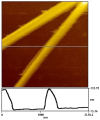Linear Graphene Nanocomposite Synthesis and an Analytical Application for the Amino Acid Detection of Camellia nitidissima Chi Seeds
- PMID: 28772805
- PMCID: PMC5506894
- DOI: 10.3390/ma10040443
Linear Graphene Nanocomposite Synthesis and an Analytical Application for the Amino Acid Detection of Camellia nitidissima Chi Seeds
Abstract
Husk derived amino modified linear graphene nanocomposites (aLGN) with a diameter range of 80-300 nm and a length range of 100-300 μm were prepared by a modified Hummers method, ammonia treatment, NaBH₄ reduction and phenylalanine induced assembly processes, etc. The resulting composites were characterized by transmission electron microscopy (TEM), atomic force microscopy (AFM), scanning electron microscopy (SEM), biological microscope (BM), and X-ray diffraction spectroscopy (XRD), etc. Investigations found that the aLGN can serve as the novel coating of stir bar sorptive extraction (SBSE) technology. By combing this technology with gas chromatography-mass spectrometry (GC-MS), the combined SBSE/GC-MS technology with an aLGN coating can detect seventeen kinds of amino acids of Camellia nitidissima Chi seeds, including Ala, Gly, Thr, Ser, Val, Leu, Ile, Cys, Pro, Met, Asp, Phe, Glu, Lys, Tyr, His, and Arg. Compared to a conventional polydimethylsiloxane (PDMS) coating, an aLGN coating for SBSE exhibited a better thermal desorption performance, better analytes fragmentation depressing efficiencies, higher peak intensities, and superior amino acid discrimination, leading to a practicable and highly distinguishable method for the variable amino acid detection of Camellia nitidissima Chi seeds.
Keywords: Camellia nitidissima Chi; amino acid; linear graphene nanocomposites; stir bar sorptive extraction.
Conflict of interest statement
The authors declare no conflict of interest. The founding sponsors had no role in the design of the study; in the collection, analyses, or interpretation of data; in the writing of the manuscript, and in the decision to publish the results.
Figures






Similar articles
-
Primary and tertiary structure of the principal human adenylate kinase.Eur J Biochem. 1976 Sep;68(1):281-90. doi: 10.1111/j.1432-1033.1976.tb10787.x. Eur J Biochem. 1976. PMID: 183954
-
The amino acid sequence of human chorionic gonadotropin. The alpha subunit and beta subunit.J Biol Chem. 1975 Jul 10;250(13):5247-58. J Biol Chem. 1975. PMID: 1150658
-
Amino acid sequence of Desulfovibrio vulgaris flavodoxin.J Biol Chem. 1977 Feb 25;252(4):1453-63. J Biol Chem. 1977. PMID: 402366
-
The primary structure of human liver manganese superoxide dismutase.J Biol Chem. 1984 Oct 25;259(20):12595-601. J Biol Chem. 1984. PMID: 6386798
-
Primary structure of murine major histocompatibility complex alloantigens: amino acid sequence of the amino-terminal one hundred and seventy-three residues of the H-2Kb glycoprotein.Biochemistry. 1980 Jan 22;19(2):306-15. doi: 10.1021/bi00543a009. Biochemistry. 1980. PMID: 6986168
Cited by
-
Nanosorbents as Materials for Extraction Processes of Environmental Contaminants and Others.Molecules. 2022 Feb 5;27(3):1067. doi: 10.3390/molecules27031067. Molecules. 2022. PMID: 35164332 Free PMC article. Review.
-
Novel Graphene/In2O3 Nanocubes Preparation and Selective Electrochemical Detection for L-Lysine of Camellia nitidissima Chi.Materials (Basel). 2020 Apr 24;13(8):1999. doi: 10.3390/ma13081999. Materials (Basel). 2020. PMID: 32344715 Free PMC article.
-
Removal of methylene blue dye by solvothermally reduced graphene oxide: a metal-free adsorption and photodegradation method.RSC Adv. 2019 Nov 19;9(64):37686-37695. doi: 10.1039/c9ra05793e. eCollection 2019 Nov 13. RSC Adv. 2019. PMID: 35542257 Free PMC article.
-
Mapping and Optically Writing Nanogap Inhomogeneities in 1-D Extended Plasmonic Nanowire-on-Mirror Cavities.ACS Photonics. 2024 Dec 10;11(12):5205-5214. doi: 10.1021/acsphotonics.4c01443. eCollection 2024 Dec 18. ACS Photonics. 2024. PMID: 39712394 Free PMC article.
References
-
- Diba M., Fam D.W.H., Boccaccini A.R., Shaffer M.S. Electrophoretic deposition of graphene–related materials: A review of the fundamentals. Prog. Mater. Sci. 2016;82:83–117. doi: 10.1016/j.pmatsci.2016.03.002. - DOI
-
- Shao Y., Wang J., Wu H., Liu J., Aksay I.A. Graphene based electrochemical sensors and biosensors: A review. Electroanalsis. 2010;22:1027–1036. doi: 10.1002/elan.200900571. - DOI
-
- Cheng J.S., Zhang G.C., Du J., Tang L.H., Xu J.Y., Li J.H. New role of graphene oxide as active hydrogen donor in the recyclable palladium nanoparticles catalyzed ullmann reaction in environmental friendly ionic liquid/supercritical carbon dioxide system. J. Mater. Chem. 2011;21:3485–3494. doi: 10.1039/c0jm02396e. - DOI
-
- Cheng J., Du J. Facile synthesis of germanium-graphene nanocomposites and their application as anode materials for lithium ion batteries. CrystEngComm. 2012;14:397–400. doi: 10.1039/C1CE06251D. - DOI
LinkOut - more resources
Full Text Sources
Other Literature Sources
Molecular Biology Databases
Miscellaneous

